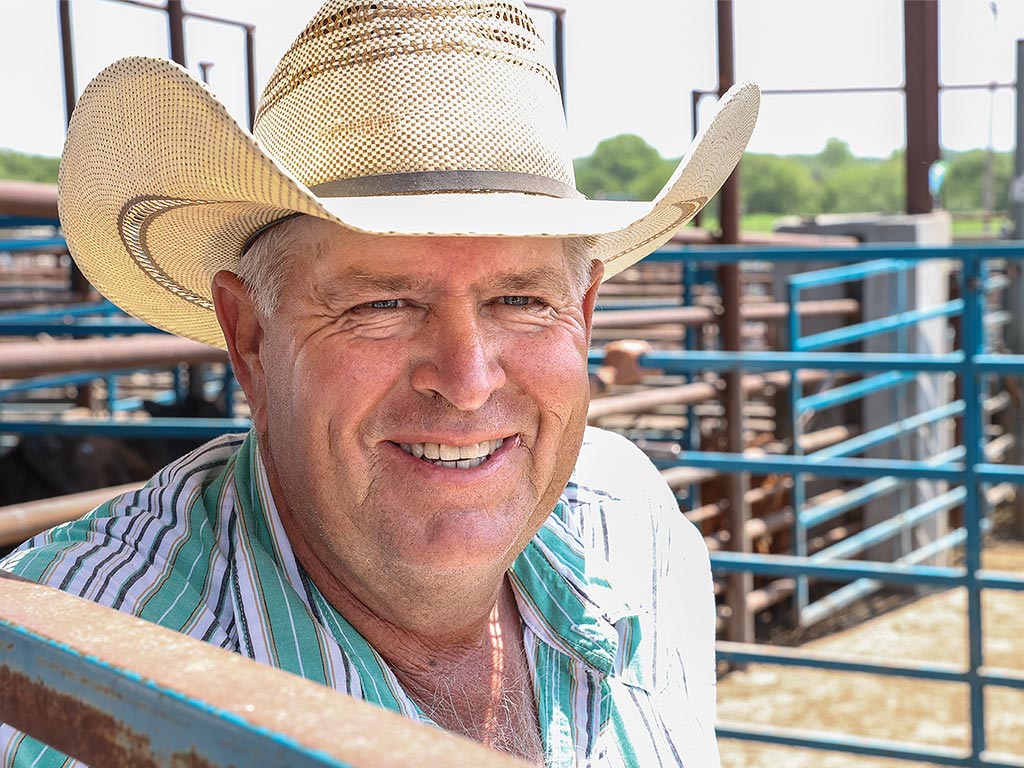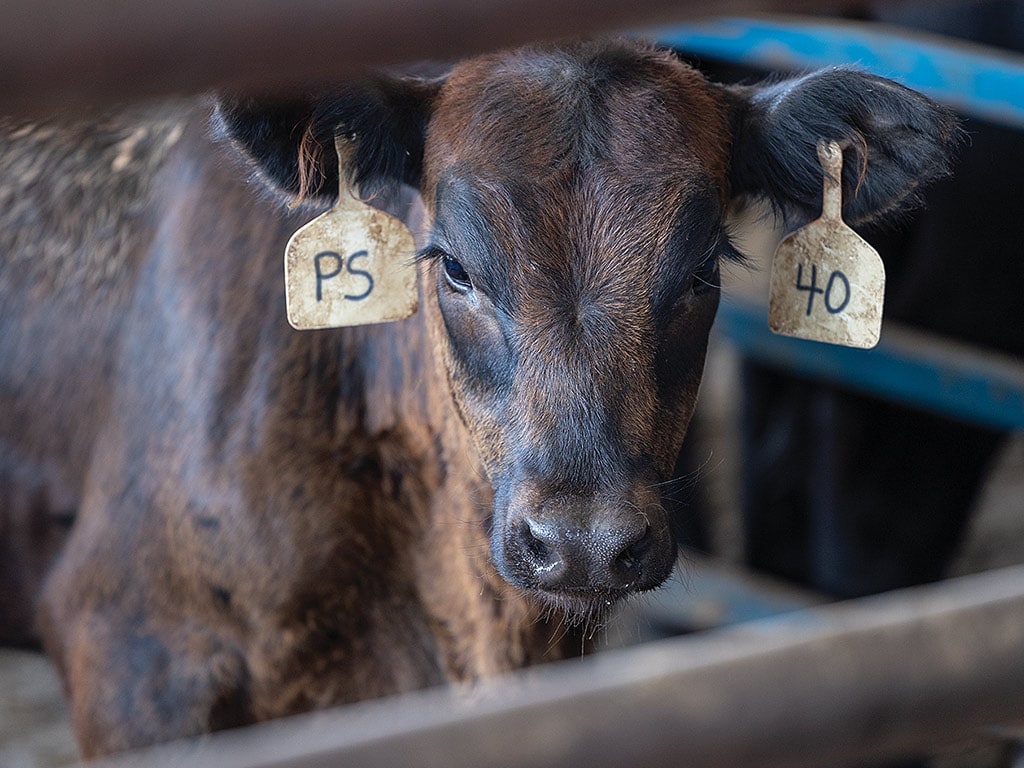Agriculture, Livestock/Poultry January 01, 2024
Sale Day in Mankato
.
A small town's sale barn is a boon to this county.
When the trucks and trailers begin rumbling through downtown Mankato, Kansas, on Thursday, this old county seat community comes alive.
They come from the east and west on U.S. Highway 36 in all shapes and sizes, from pickup trucks with small trailers to big rigs with giant cattle pots, headed north beside Mac's Kwik Stop on the traffic-worn bricks of Commercial Street.
Slowly they roll past the Jewell County Courthouse, built in 1938 of native yellow limestone. Their destination is the Mankato Livestock Incorporated sale barn at the north edge of town.
"Some days I don't know if it's thundering outside or cattle trailers on the road," Phil Menhusen, president of the locally owned State Exchange Bank, says appreciatively.
Above. In 2018, owners built a new sale barn and added pen space at MLI. Buyers and sellers at Mankato Livestock, Inc. are passionate about beef. High school student Curtis Garman and his dad, John, of Courtland, Kansas, settle up with clerk Cheyenne Meyer after Curtis bought his first two steers in August, 2023. Incoming cattle are inspected and given a barcode by a veterinarian at Mankato Livestock, Inc. Auctioneer Neil Bouray is one of the sale barn's owners. Steven Walker, Walker Auto Service, says livestock auction traffic brings more business to his service station. Kathy Jensen and her husband, Carl, own the Buffalo Roam Steakhouse in Mankato. Sale days bring in more diners. Auctioneer Matt Becker called his first sale at age 15. Co-owner Jon Russell has a knack for cattle, customers say. Banker Brian Shulda credits the sale barn with bringing in an influx of money to Jewell County. Sale barn co-owner Scott Greene says Mankato Livestock is passionate about helping youth by bidding at 4-H premium auctions in several surrounding counties.
Economic boon. In this little town, the sale barn is a heartbeat of local commerce. Cattle producers from near and far bring their stock here nearly each week throughout the year (bi-weekly during the summer months), with some 100,000 head passing through the sale barn gates each year. The economic impact of this sale barn to Mankato and Jewell County is tremendous, Menhusen says.
Kansas has 41 livestock auction markets; many are bigger than the one in Mankato. But it is hard to argue that any of them have more impact on the local community than does Mankato Livestock.
In a town this size—850 residents as of the last U.S. Census—the ripple effect is massive. On Thursdays and Fridays of sale weeks, the town's three restaurants serve more meals, Kier's Thriftway sells more groceries, Mankato Professional Pharmacy fills more prescriptions, and Walker Automotive Service pumps more fuel and patches more tires.
According to a 2023 impact study from the Livestock Marketing Association, an average livestock auction market provides about $2 million in added value to its local community. The study was conducted in a rural Missouri town with weekly auctions featuring all classes of cattle.
"Livestock auction markets today remain critical to helping our rural communities continue to thrive," says Kristen Parman, LMA Vice President of Membership Services. "They generate a competitive sale environment which results in cash for local livestock producers. That cash equals dollars spent in town and investments back into their businesses and operations."
Mankato is the county seat in Jewell County, adjoining the Nebraska border in the central part of the state. Agriculture—whether it is farming, ranching, or support services—is its only industry.
Like many rural counties, Jewell faces population loss. About 2,900 people live here now; a century ago, 16,200 people called Jewell County home.
The population decline has been steady and has taken a toll on the county's businesses. There are empty storefronts in most of the county's largest communities.
So in 2018, when the four owners of Mankato Livestock opted to build a brand new facility and expand its pen space to safely accommodate more cattle, businesses were thrilled.
"I think we're extremely lucky to have the sale barn in town," says Brian Shulda, executive vice president at the State Exchange Bank and board member for the Jewell County Community Development Association. "The sale barn draws from 60 to 90 miles away, and the amount of dollars that comes through here is huge. How much of that stays in Mankato? I don't know. But there is an impact."
Holding court. Inside the sale barn café, Marilyn Shaw serves up a weekly special on sale days. Fourteen bucks buys an entrée—brisket, this week—plus potatoes, a salad, and iced tea or lemonade; a slice of pie is a little extra.
Bill Roe holds court at the second table from the door. The retired cattleman from Webber, Kansas, is 89 years old. His brother Lauren died in 2020, and Bill turned Roe Land and Cattle over to his grandson not long after. His eyes shine bright as he swaps stories with 93-year-old Norman Greene at the dinner table. Roe and Greene swap stories about the old days, driving cattle with mules, trucking cattle all over multiple states, and buying and selling cattle.
Greene was asked what it takes to be a successful cattle buyer.
"Secret? There ain't no secret," he replies. "You've just got to be foolish."
"Hah," Roe responds. "Norm Greene didn't get where he is by being foolish."
Above. Tracking prices at one of the weekly sales at Mankato Livestock, Inc. Drew Winder and Corbin Greene sort cattle prior to the sale. In a 12-week span in 2018, the sale barn owners razed the existing barn, built in 1929, and built a new facility with safer pens and gates. A steer calf awaits new owners.
Young guns. To the crowd of beef producers and cattle buyers in attendance, the two auctioneers manning the microphone in the arena are just kids.
The truth is, Matt Becker and Neil Bouray have been calling bids for years.
Becker was set to begin his senior year in high school and had been working a few years in the pens at the sale barn. He attended auctioneer school while still in high school, and the summer before his senior year he was asked to go call bids.
"There were only one or two buyers and we were selling cows, but it was nerve-racking," he recalls. "I got a taste of what it was like and I wanted more of it. I'll never forget that."
Neil's story goes back even further. His great-grandfather Ed Montgomery, grandfather Andy Montgomery, and mother Kelly Bouray, all preceded him as auctioneers. Neil began calling bids at age 10 at local household and farm sales; he first stepped into The Box to sell livestock at age 12. It never gets old, he says.
"The rapid pace, the speed of the auction, the interaction with buyers…it's exciting," he explains.
Having worked together for years, the pair complement each other. Their styles are different; Bouray's is molded after his family members, while Becker learned from an auctioneer from Mankato. "You get a certain rhythmic sound from the people you listen to growing up," Bouray explains. "Today, beginning auctioneers can listen to auctioneers from all over the country on YouTube and Facebook. I had an old cassette tape I listened to over and over."
Each is an award-winning livestock auctioneer. Bouray has qualified for the World Livestock Auctioneer Championship multiple times, while Becker was second at the 2023 Kansas Auctioneer Championship.
Mankato Livestock has a solid reputation among cattle producers due to its local ownership, including Neil Bouray, Kelly Bouray, Jon Russell, Scott Greene and the two dozen or so people who work there each week. Their collective reputation is one of integrity and collective wisdom about the cattle entering the ring, who is selling them, what the buyers' needs are and how each lot of cattle can serve them.
"About 90% of the time, you know who is going to bid on each lot," Becker says. "In the ring, Jon Russell starts everything off and it kind of goes from there."
Russell is the quintessential cattle man, Norm Greene adds.
"I've sat next to him at a cattle sale, and he's talking to me, he's talking to the guy on the other side of him, he's on the phone with a buyer and he's paying attention to the sale," he says. "He remembers everything he's ever learned about cattle."
Payday. One week, Mankato Livestock may sell 800 head; the next, 3,000. Each customer and each animal is just as important as the next one.
"We are representing the sellers and their livelihoods," Bouray says. "They get a paycheck one day per year, and that's the day."
Farmers and ranchers in Jewell County and the five surrounding counties care for more than 200,000 cattle and calves each year, according to the National Ag Statistics Service. There is a tremendous need for a reputable livestock auction market.
"This is big cow-calf country," Menhusen says. "Having a sale barn that gets our producers' prices competitive with what they can get anywhere else is vital. It saves producers transportation costs; it limits stress on the animal.
"But the key is, the sale barn brings in cattle buyers," he adds. "Our producers know every Friday the buyers will be there." ‡
Read More

AGRICULTURE, SUSTAINABILITY
The Good Life
Growing protein demand comes with more consumer demands.

AGRICULTURE, LIVESTOCK/POULTRY
Meat Straight From the Farm
USDA-inspected on-farm slaughter meets quality and economic goals.















